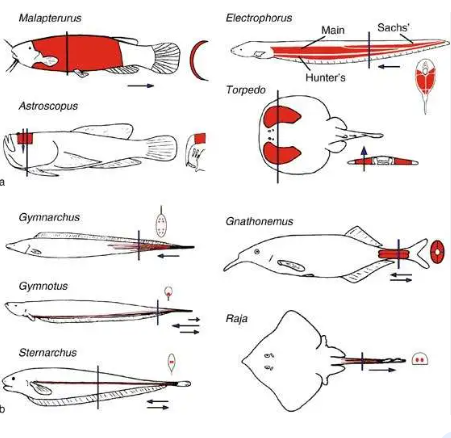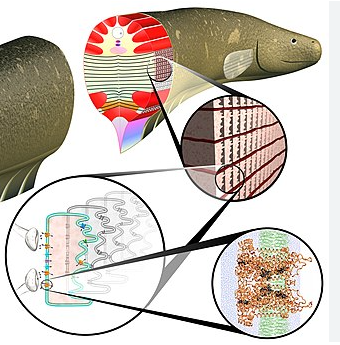
Table of Contents
Introduction
Electric organs are specialized structures found in certain fish, such as electric eels and some catfish, enabling them to generate electric fields for communication, navigation, and hunting. These organs consist of electrocytes, specialized cells arranged in patterns within the organ. Electric fish use the generated electric fields for communication, conveying information about species, sex, and social status.
Additionally, these fish employ electric fields for navigation, emitting pulses to sense their environment and locate obstacles, even in darkness. Some species use electric discharges for defense against predators or stunning prey during hunting. The study of electric organs not only enhances our understanding of the fascinating adaptations in aquatic life but also has biomedical implications, contributing to research in bioelectricity, neurobiology, and the development of bio-inspired technologies.

Evolution of Electric Organs
The evolution of electric organs in fish is a remarkable example of how organisms adapt to their environments over time. While electric organs are found in various fish species today, they have evolved independently in different lineages. The development of these organs likely stems from the selective pressures in the aquatic ecosystems where these fish reside. Electric organs provide significant advantages, such as enhanced communication, navigation, and predatory abilities.
Over evolutionary time, genetic changes and natural selection have favored the development and optimization of electrocytes, the specialized cells responsible for generating electric fields. These adaptations have allowed electric fish to thrive in diverse habitats, from murky waters where vision is limited to environments where electric communication and navigation confer a competitive edge. Studying the evolution of electric organs not only sheds light on the intricacies of natural selection but also reveals the fascinating ways in which living organisms have harnessed electricity for their survival and ecological success.
Types of Electric Organs
There are various types of electric organs found in different fish species, each adapted to serve specific purposes. Two main groups of fish, knifefishes, and certain catfish, possess these specialized organs. One notable type is found in electric eels (Electrophorus electricus), which have a strong electric organ used for both hunting and self-defense. Electric catfish, such as Malapterurus electricus, also possess electric organs, generating electric fields for navigation and communication.
Additionally, knifefish, like the elephantfish (mormyrids), exhibit a specialized electric organ that aids in electrolocation for prey detection. The organization and structure of these electric organs vary among species. Some fish have electrocytes arranged in parallel stacks, while others have them in series. The diversity of electric organs across fish species highlights the versatility of this adaptation and its role in different ecological strategies, from communication and navigation to hunting and defense.
Functionality and Mechanism
The functionality of electric organs in fish is intricately tied to their ability to generate electric fields, serving various purposes crucial for survival and ecological adaptation. The mechanism involves specialized cells called electrocytes, arranged in specific patterns within the electric organ. These electrocytes generate electric pulses through the controlled flow of ions across their membranes.
The organ’s overall electric field is generated in part by the coordination of thousands of electrocytes.. The functionality of these electric fields includes communication, where fish use them to convey information about species, sex, and social hierarchy. Electric organs also play a crucial role in navigation, as some fish emit weak electric pulses and detect distortions caused by nearby objects, enabling them to navigate their environment even in darkness.
For certain species, the electric fields are employed in electrolocation, helping them detect and locate prey. In cases like electric eels, the electric organs can produce strong electric discharges, serving both as a means of self-defense against predators and as a tool for stunning prey during hunting. The intricate interplay between the functionality and mechanism of electric organs underscores the remarkable adaptations that have evolved in different fish species to thrive in their respective habitats.
Significance in Aquatic Ecosystems
The presence of electric organs in certain fish species holds significant ecological importance within aquatic ecosystems. These specialized adaptations confer several advantages, influencing the behavior and interactions of these fish and contributing to the overall dynamics of their environments.
Firstly, the electric fields generated by these organs play a crucial role in communication. Fish use electric signals to convey information about their species, sex, and social status. This form of communication aids in the establishment of territories, the formation of social hierarchies, and the coordination of reproductive activities.
Secondly, electric organs contribute to navigation. Fish emitting electric pulses can use the distortions caused by nearby objects to navigate their surroundings effectively, enabling them to detect obstacles, find mates, and locate suitable habitats. This navigation capability is especially valuable in environments with limited visibility.
Furthermore, electric organs are employed in electrolocation, allowing fish to detect and locate prey by sensing the electric fields generated by other living organisms. This enhances their hunting efficiency and facilitates successful foraging.
In terms of defense and predation, electric organs provide a means of self-defense against predators. Some fish, like the electric eel, can generate strong electric discharges, deterring potential threats. On the offensive side, electric fields can be used to stun or immobilize prey, providing a strategic advantage during hunting.
Overall, the presence of electric organs in fish contributes to the intricate web of relationships and adaptations within aquatic ecosystems. It highlights the diverse ways in which organisms have evolved to thrive in specific ecological niches, showcasing the interconnectedness of life in water environments.

Human Applications
The unique capabilities of electric organs in certain fish have inspired various applications in the human context, ranging from scientific research to technological innovations. Some notable human applications include:
- Bioelectricity Research: Studying electric organs in fish provides insights into the generation and control of bioelectric signals. This research contributes to our understanding of neurobiology and bioelectricity, with potential applications in fields such as medicine and neuroscience.
- Medical Devices: The principles learned from electric organs have influenced the development of medical devices, particularly in the design of implantable devices that interact with the nervous system. Understanding how electric signals function in living organisms can aid in creating more effective neurostimulation devices for conditions like chronic pain, Parkinson’s disease, and epilepsy.
- Sensory Substitution: The electrolocation abilities of some fish, where they use electric fields to navigate and detect objects, have inspired researchers to explore sensory substitution technologies for humans. These technologies aim to assist individuals with visual or auditory impairments by converting environmental information into alternative sensory signals.
- Underwater Exploration: Bio-inspired technologies derived from electric organs have been applied in the development of underwater exploration tools. These tools can mimic the capabilities of electric fish, helping researchers navigate and survey underwater environments where traditional methods may be challenging.
- Robotics: The principles behind electric organs have influenced the field of biomimetics, where researchers draw inspiration from nature to design robots. Some underwater robots are designed to emulate the electric-field sensing abilities of fish, enabling them to navigate and detect objects in murky or dark underwater environments.
- Communication Technologies: The study of electric communication in fish has implications for the development of underwater communication technologies. Understanding how fish use electric signals to convey information may inspire advancements in underwater communication systems for human use.
- Monitoring of the Biological and Environmental Environment: Fish electric fields can be used for biological and environmental monitoring. Researchers are exploring the use of electric signals as indicators of water quality and the presence of specific fish species in aquatic ecosystems.
Biology of Electric Organisms
Exploring the biology of electric organisms unveils the intricate anatomy of electric fish. Understanding electric organ discharges (EODs) provides a glimpse into the communication strategies and sensory functions that these organisms have developed over millions of years.
The biology of electric organisms encompasses various aspects related to the structure, function, and ecological roles of these unique adaptations found in certain fish species. Key elements of the biology of electric organisms include:
- Structure: Electric organisms possess specialized structures known as electric organs, which are composed of electrocytes—specialized cells that generate electric fields. The arrangement of electrocytes within the organ, whether in series or parallel, varies among species.
- Function: The primary function of electric organs is to produce electric fields, which serve multiple purposes. These include communication, navigation, electrolocation for prey detection, and in some cases, as a means of defense or stunning prey during hunting.
- Communication: Electric organisms use electric signals for communication within their species. These signals convey information about identity, species, sex, and social status. The ability to communicate through electric fields is particularly useful in environments where visual or acoustic communication may be limited.
- Navigation: The electric fields generated by these organisms aid in navigation. By emitting electric pulses and sensing distortions caused by nearby objects, fish can effectively navigate their environment, even in conditions of low visibility.
- Electrolocation: Some electric organisms, such as certain catfish and mormyrids, use electric fields to detect and locate prey. To find food sources in their surroundings, they release electric pulses and detect variations in the electric field brought about by surrounding objects.
- Adaptations for Hunting and Defense: In species like the electric eel, the electric organ can produce strong electric discharges. This capability is used both for hunting, where it stuns or immobilizes prey, and as a means of self-defense against potential predators.
- Evolutionary Significance: The presence of electric organs in certain fish species represents a remarkable example of convergent evolution, where similar adaptations evolve independently in different lineages. The evolution of electric organs underscores the selective pressures and ecological niches that have shaped the diversity of these organisms over time.
- Ecological Roles: Electric organisms play crucial roles in aquatic ecosystems. Their ability to communicate, navigate, and locate prey contributes to their ecological success and influences interactions with other species in their habitats.
Understanding the biology of electric organisms provides valuable insights into the diversity of life, the intricacies of adaptation to specific environments, and the functional roles that unique adaptations play in the broader context of ecosystems. Additionally, the study of these organisms has practical applications in fields such as bioelectricity, neuroscience, and bio-inspired technologies.
Challenges and Threats
Electric organisms, despite their unique adaptations, face various challenges and threats in their natural habitats. Some of these challenges are inherent to their biology and ecological niche, while others are anthropogenic in nature. Here are several challenges and threats that electric organisms may encounter:
- Habitat Loss and Degradation: Like many other aquatic species, electric organisms are susceptible to habitat loss and degradation due to factors such as deforestation, pollution, and human development. Alterations to their natural habitats can disrupt their ecological balance and reduce available resources.
- Pollution: Water pollution, including chemical pollutants and heavy metals, poses a significant threat to electric organisms. Pollution can affect water quality, impacting their health, reproductive success, and overall survival. Additionally, contaminants may accumulate in their tissues, leading to long-term physiological problems.
- Climate Change: Changes in temperature, water flow, and other environmental conditions associated with climate change can have profound effects on the habitats of electric organisms. These changes may disrupt breeding patterns, alter food availability, and influence the distribution of species.
- Overfishing: Some electric organisms are targeted for fishing due to their unique features or as a part of traditional practices. Overfishing can deplete their populations, leading to declines and potential ecological imbalances within their habitats.
- Invasive Species: Introduction of non-native species to water bodies can pose a threat to electric organisms. Invasive species may compete for resources, introduce new diseases, or even prey on electric organisms, impacting their populations.
- Hydroelectric Dams: The construction of hydroelectric dams can alter riverine ecosystems and impact the natural behaviors of electric organisms. Changes in water flow and the creation of barriers can affect migration patterns and disrupt breeding grounds.
- Human Disturbances: Recreational activities, boat traffic, and other human disturbances in aquatic ecosystems can disturb the natural behaviors of electric organisms. Constant disruptions may affect their ability to communicate, navigate, and hunt effectively.
- Selective Pressures: In the wild, electric organisms face ongoing selective pressures, including competition for resources and predation. Changes in their ecosystems, combined with natural evolutionary processes, may pose challenges to their long-term survival.
- Disease: Like any living organisms, electric fish are susceptible to diseases. Changes in environmental conditions, pollution, or the introduction of pathogens can increase their vulnerability to diseases, potentially leading to population declines.
- Limited Research and Conservation Efforts: Many electric organisms are not as well-studied as other species, and their conservation status may not be adequately understood. Limited research and conservation efforts can hinder effective strategies for their protection and preservation.
Addressing these challenges requires a combination of scientific research, habitat conservation, and sustainable management practices. Understanding the ecological requirements and vulnerabilities of electric organisms is essential for developing effective conservation strategies to ensure the long-term survival of these unique and ecologically important species.
Fascinating Examples
Electric organisms, such as the electric eel, present captivating examples of evolutionary adaptations within the aquatic realm. The electric eel, native to South America’s Amazon and Orinoco river basins, stands out for its ability to generate potent electric discharges. This species employs its specialized electrocytes, arranged in series, for navigation, communication, and as a formidable tool for hunting and self-defense. In Africa, the electric catfish and elephantfish exhibit similar electrifying capabilities.
The electric catfish, dwelling in the Nile River, deploys continuous and pulse-type electric discharges for communication and prey detection. Elephantfish, with their elongated snouts and electroreceptor organs, rely on weak electric fields for navigation and communication. Further south, the ghost knifefish of South America, known for its nocturnal habits, employs weak electric fields to navigate and locate prey in low-light conditions. These examples showcase the remarkable diversity of electric organisms, underscoring the ways in which they have evolved to thrive in their respective environments through the ingenious use of bioelectricity.
Current Research and Discoveries
Current research on electric organisms continues to unravel fascinating aspects of their biology, behavior, and the potential applications of their unique features. Scientists are exploring various avenues to expand our understanding of these organisms and their contributions to fields beyond biology.
- Neurobiology and Bioelectricity: Ongoing research delves into the neurobiology of electric organisms, aiming to unravel the intricacies of how their nervous systems control the generation and modulation of electric fields. This research has broader implications for understanding bioelectricity in general and may contribute to advancements in neurobiology and medicine.
- Genomics and Evolution: Advances in genomics are enabling researchers to explore the genetic basis of electric organ development and function. Comparative genomics studies across different electric fish species shed light on the evolutionary processes that have led to the convergence of electric organ traits in unrelated lineages.
- Applications in Biomedicine: The bioelectricity produced by living things that are powered by electricity is driving advancements in the field of biomedicine.. Researchers are exploring ways to harness electric signals for medical applications, including the development of bio-inspired devices for neurostimulation, prosthetics, and even potential therapies for neurological disorders.
- Biomimicry in Robotics: Electric organisms serve as inspiration for the design of bio-inspired robots. The ability of these fish to navigate and sense their environment using electric fields has led to the development of underwater robots that can mimic these capabilities. Such robots have potential applications in environmental monitoring and exploration.
- Conservation and Ecological Studies: Ongoing research focuses on the conservation status of electric fish species and their roles in aquatic ecosystems. Understanding their ecological interactions, population dynamics, and responses to environmental changes is crucial for developing effective conservation strategies.
- Behavioral Studies: Scientists are conducting in-depth behavioral studies to decipher the intricate communication patterns and social behaviors exhibited by electric organisms. This research enhances our understanding of their complex interactions within their habitats.
- Technological Advancements: Advancements in technology, such as high-resolution imaging and tracking techniques, enable researchers to observe and study electric organisms in their natural environments more effectively. This allows for a more comprehensive understanding of their behaviors and ecological roles.
- Synthetic Biology: Some researchers are exploring synthetic biology approaches to engineer non-electric fish species with electric organ-like structures. This line of research aims to understand the genetic and molecular mechanisms underlying electric organ development and could potentially lead to the creation of artificial electric organs for various applications.
Ethical Considerations
As researchers delve deeper into the world of electric organs, ethical considerations arise. The use of electric fish in research raises questions about the ethical treatment of these organisms and the responsible use of knowledge gained from studying them.
Future Prospects
Looking ahead, the future holds exciting prospects for electric organs. From potential applications in renewable energy to ongoing research endeavors, these unique biological structures continue to captivate the scientific community and inspire new possibilities.
Conclusion
In conclusion, electric organs stand as nature’s electrifying wonders, showcasing the brilliance of adaptation and evolution. Their significance in aquatic ecosystems, coupled with their diverse applications in human endeavors, underscores the need for continued research, conservation efforts, and ethical considerations.
Find out this article
FAQs About Electric Organs
- What is the purpose of an electric organ in fish?
- Electric organs in fish serve various purposes, including communication, navigation, and prey detection.
- Are electric rays harmful to humans?
- While electric rays can generate electric discharges, they are not typically harmful to humans unless provoked.
- Can electric organs be replicated for human use?
- Researchers explore the potential for replicating electric organs for medical and technological applications, but significant challenges remain.
- How do electric eels generate electric shocks?
- Electric eels have specialized cells called electrocytes that generate electric discharges when activated.
- What is the role of electric organs in navigation?
- Electric organs play a crucial role in navigation for certain fish species, helping them detect obstacles and locate prey.









